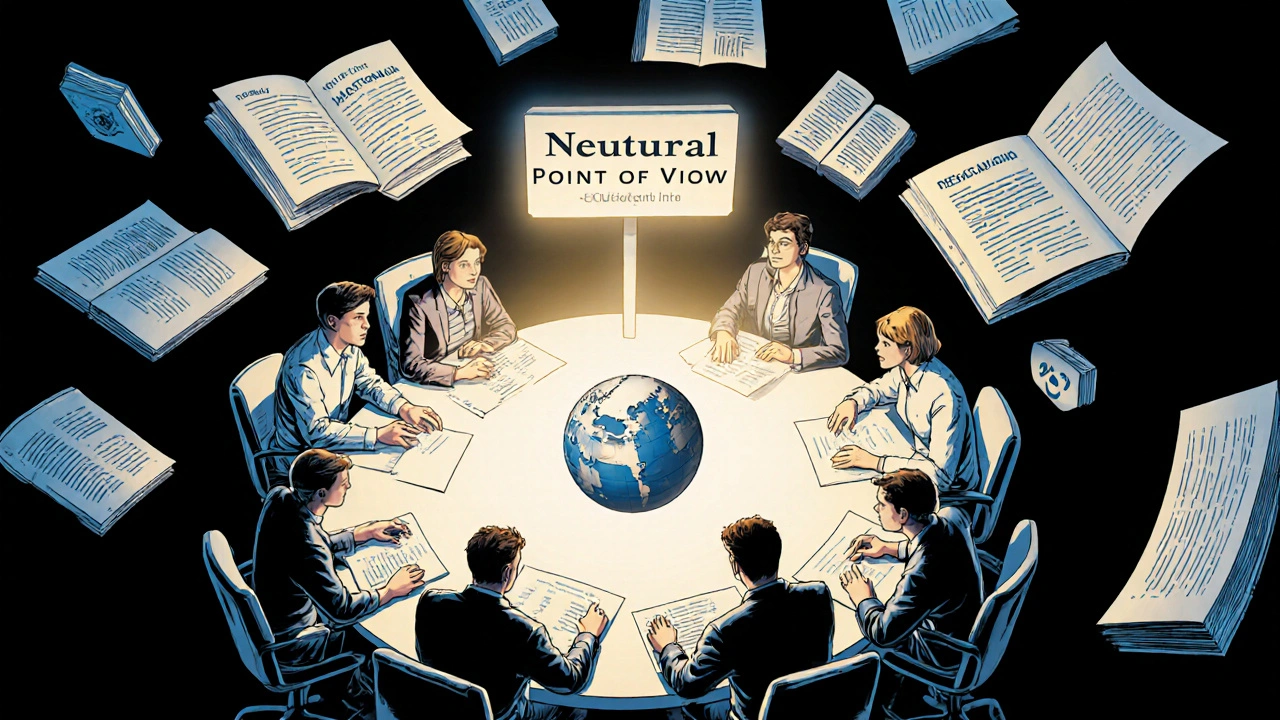
Wikipedia doesn’t take sides on religion. That’s not because it’s indifferent-it’s because it has to be precise. Millions of people around the world rely on Wikipedia to understand beliefs they don’t share. A Muslim in Jakarta, a Christian in São Paulo, an atheist in Berlin-they all expect the same facts, not opinions. Getting that right isn’t easy. Religion touches identity, history, emotion, and politics. One word can spark outrage. One omission can feel like erasure. So how does Wikipedia stay neutral when the topic is anything but?
Neutral doesn’t mean silent
Wikipedia’s policy on neutrality, called Neutral Point of View (NPOV), doesn’t ask editors to ignore religion. It asks them to represent it fairly. That means describing beliefs as they are held, not as someone wishes they were. If a group believes in reincarnation, Wikipedia says so. If another group rejects it, Wikipedia notes that too. The goal isn’t to balance every claim with an equal counterclaim-it’s to reflect what reliable sources say, without adding personal judgment.Take the article on Christianity. It doesn’t say Jesus is the Son of God because that’s a theological claim. Instead, it says, “Christians believe Jesus is the Son of God,” and then cites major denominations and scholarly sources that explain how that belief developed. The same applies to Islam, Buddhism, Hinduism, and smaller faiths. The article doesn’t favor one interpretation over another. It just reports what exists.
Reliance on reliable sources
Wikipedia doesn’t invent religious doctrine. It doesn’t let editors decide what’s true or false. Instead, it leans on published, credible sources-academic books, peer-reviewed journals, major news outlets, and official religious publications. A claim like “The Pope supports climate action” isn’t added because an editor believes it. It’s added because The New York Times, the Vatican’s official press office, and the BBC all reported it.When sources conflict, Wikipedia doesn’t pick a winner. For example, some scholars argue that early Islam was heavily influenced by Jewish and Christian traditions. Others say those influences were minimal. Wikipedia presents both views, citing the researchers behind each. It doesn’t say which is more correct. It says: here’s what experts have published.
This reliance on sources keeps the platform from becoming a battleground for theological debates. A Mormon editor can’t rewrite the article on Joseph Smith to make him sound like a prophet. A secular historian can’t remove references to divine revelation. Both must ground their edits in published work. That’s the rule. And it’s enforced by thousands of volunteer editors who monitor changes daily.
Handling controversial claims
Some religious claims are scientifically disputed-like creationism versus evolution, or the historical existence of figures like Moses. Wikipedia handles these by separating belief from evidence. It doesn’t say “Creationism is wrong.” It says, “Creationism is a belief held by some religious groups that the universe was created by a divine being in a literal six-day period, as described in the Book of Genesis. This view is rejected by the scientific community, which supports the theory of evolution based on fossil records, genetics, and radiometric dating.”That’s the difference: it describes the belief, then reports what the scientific consensus says. It doesn’t mock the belief. It doesn’t elevate it. It just lays out what people believe and what experts conclude. The same approach applies to claims about miracles, afterlife experiences, or spiritual healing. If a group reports them, Wikipedia notes that. If science finds no evidence, Wikipedia says so too.
Dealing with bias in sources
Not all sources are created equal. Some religious organizations publish materials that present their own views as absolute truth. Wikipedia knows this. So it doesn’t take those sources at face value. Instead, it looks for independent verification. If a church website claims “90% of its members report miracles,” Wikipedia won’t accept that without a peer-reviewed study or a reputable survey backing it up.When biased sources are the only ones available, Wikipedia adds context. For example, an article on Scientology might quote a church pamphlet-but it will also cite investigative journalism from The New Yorker, court records, or academic analyses that challenge the church’s claims. The article doesn’t just repeat the pamphlet. It shows the reader where the claim came from, and what others say about it.

How small faiths get represented
It’s easy to overlook religions with fewer followers. But Wikipedia doesn’t ignore them. The article on Rastafari, for instance, includes its origins in Jamaica, its reverence for Haile Selassie, its dietary practices, and its use of cannabis in rituals. It doesn’t label it as “weird” or “exotic.” It treats it like any other belief system-with the same level of detail and respect.Editors who belong to minority faiths often help write these articles. A Buddhist in Thailand might add details about Theravada practices. A follower of the Baha’i Faith in Canada might clarify how their community views gender equality. These contributions aren’t promotional. They’re factual. And they’re reviewed by others who may not share the same beliefs. That’s how Wikipedia avoids letting one group dominate the narrative.
What happens when edits go wrong
Bias doesn’t always come from outside. Sometimes, it comes from well-meaning editors who think they’re helping. A Christian editor might delete references to non-theistic interpretations of the Bible. A secular editor might remove mentions of prayer in historical contexts. These edits get flagged. Other editors revert them. And if the behavior continues, the user may be blocked.Wikipedia has a system called “edit warring” protection. If two editors keep changing the same article back and forth, the page gets locked. A neutral third party steps in. They review the edits, check the sources, and restore balance. This has happened dozens of times on articles about Islam, Judaism, and Mormonism.
There’s also a formal dispute resolution process. If an editor feels unfairly treated, they can request mediation. Panels of experienced volunteers, trained in religious neutrality, review the case. They don’t decide who’s right or wrong. They decide if the article follows policy. If it doesn’t, they fix it.
Real examples of neutral coverage
The article on the Catholic Church’s stance on contraception doesn’t say it’s right or wrong. It says: “The Catholic Church teaches that artificial contraception is morally wrong, based on its interpretation of natural law and scripture. This position is outlined in documents like Humanae Vitae (1968). Many Catholics disagree with this teaching, and surveys show that a majority in Western countries use contraception.”The article on atheism doesn’t say religion is false. It says: “Atheism is the absence of belief in deities. It is not a religion, nor does it require organized structure. Atheists may hold diverse views on morality, politics, and science.” It then lists prominent atheist thinkers, their writings, and the cultural impact of atheism in different countries.
The article on indigenous spiritual practices doesn’t call them “primitive.” It describes ceremonies, cosmologies, and oral traditions as they are understood by the communities themselves-citing anthropological fieldwork and community-led publications.

Why neutrality matters
Neutrality isn’t just a policy. It’s what keeps Wikipedia usable. If the site favored one religion, others would leave. If it mocked beliefs, trust would collapse. In a world where religious conflict fuels division, Wikipedia offers something rare: a shared space where people can learn about each other without being preached to.That’s why it works. A Hindu in Mumbai and a Christian in Nashville can both open the same article on karma and walk away with the same facts. Neither feels attacked. Neither feels ignored. That’s not luck. It’s the result of a strict, well-enforced system that prioritizes evidence over emotion.
What you can do if you notice bias
If you read an article and think it’s biased, don’t just complain. Edit it. Wikipedia is open to anyone. Find a reliable source that supports your view. Add it with a citation. If you’re unsure, use the article’s talk page. Ask: “Can we cite this study to better represent this perspective?” Other editors will respond. Often, they’ll agree.Don’t try to force your belief into the article. Don’t delete opposing views. Don’t use emotional language. Stick to facts. Cite sources. Be patient. Neutral articles aren’t built overnight. They’re built by thousands of small, careful edits over years.
What Wikipedia doesn’t do
Wikipedia won’t tell you which religion is true. It won’t rank faiths by popularity. It won’t promote one belief over another. It won’t explain why you should believe something. It only tells you what people believe, and what reliable sources say about those beliefs.That’s not a weakness. It’s the point.
Does Wikipedia favor any religion?
No. Wikipedia’s policy requires all religious topics to be presented neutrally, based on reliable sources. No faith is given preferential treatment. Articles about Christianity, Islam, Buddhism, and smaller religions follow the same standards: describe beliefs, cite sources, avoid judgment.
Can I edit Wikipedia to promote my religion?
You can add factual information supported by reliable sources, but you cannot promote your religion as superior or true. Editing must follow the Neutral Point of View policy. Attempts to push doctrinal claims or use promotional language are reverted and may lead to editing restrictions.
Why doesn’t Wikipedia just say what’s true?
Wikipedia isn’t designed to determine truth-it’s designed to report what people believe and what reliable sources say. Truth claims about religion are theological or philosophical, not encyclopedic. The platform reports consensus, not conviction.
Are all religions covered equally on Wikipedia?
Coverage depends on available reliable sources and editor interest, not on the size of the religion. Major world religions have more detailed articles because more sources exist. Smaller faiths are covered when reliable documentation is available. Editors actively work to improve coverage of underrepresented traditions, but quality depends on verifiable information.
How does Wikipedia handle hate speech disguised as religious belief?
Wikipedia prohibits hate speech, even when it’s framed as religious doctrine. If an article includes language that attacks people based on religion-like calling a group evil or inferior-it is removed. The policy protects people, not beliefs. Beliefs can be described; people cannot be insulted.
Next steps for readers
If you want to understand how Wikipedia handles religion, start by reading the article on Neutral Point of View. Then, compare two articles: one on a major religion and one on a lesser-known belief system. Notice how both are written the same way-factually, respectfully, without promotion. That’s the standard. And it’s what makes Wikipedia unique.If you’re a member of a religious community, consider helping improve coverage. Find gaps. Add citations. Be patient. The goal isn’t to make your faith look better. It’s to make the world’s knowledge more complete.






